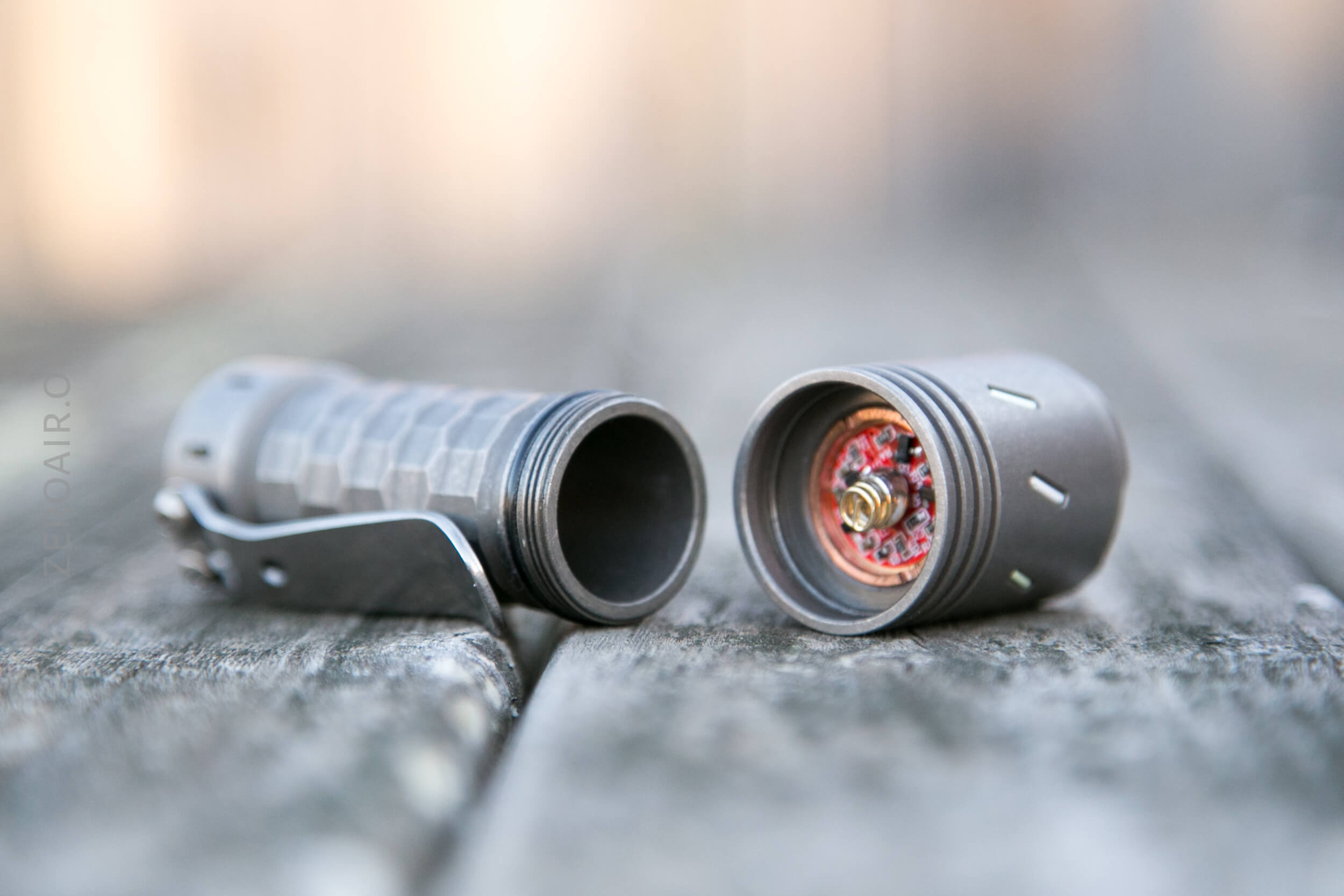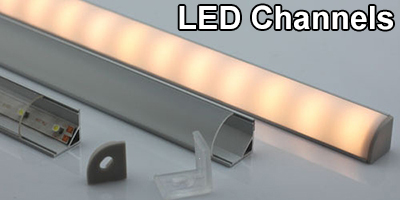zeroair
Newly Enlightened
- Joined
- Aug 6, 2016
- Messages
- 130
Reylight Krystal Flashlight Review
I humbly submit this post for consideration in the review forum!
I humbly submit this post for consideration in the review forum!

Today I am reviewing the Reylight Krystal. This is a light I wanted for a long while but … well to be honest, not at "new" prices. I finally found one used at an acceptable price. I love many things about this light, and dislike a few. Read on for thoughts and testing!!
Official Specs and Features
Here's a link to the official product page. Not a referral or anything, just a product link for you to get more info.
Versions
There are numerous versions of the Krystal but they're all essentially similar. Only one metal is available: titanium. Two finishes are possible – polished and stonewashed (seen here). And any finish can have either of two main emitters: Cree XP-L HI or Nichia 219c (seen here). There's also a secondary emitter option: red (seen here) or amber. Based on what the site shows now, the both secondary emitters might not have been available in all finishes.
There's also an additional $15 TurboGlow gasket, which I would fully recommend including.
Price and Coupon
These go (went?) for $200-220, with the Cree XP-L HI going for the higher price.
Short Review
I love the flashlightyness of this light. And as far as quads go it's very reasonably sized. The titanium threads have the typical titanium thread feel, and the UI is one that you probably never saw anywhere else. If you can't adapt to UI's very quickly, then this is probably not for you. If you're ok learning a new UI, then this might be a good snag.
Long Review
The Big Table
| ReyLight Krystal | |
|---|---|
| Emitter: | Nichia 219c |
| Price in USD at publication time: | $200-$220 |
| Cell: | 1×18350 |
| Turbo Runtime | High Runtime |
| LVP? | Yes |
| Switch Type: | Mechanical |
| On-Board Charging? | No |
| Claimed Lumens (lm) | 2500 |
| Measured Lumens (at 30s) | 1536 (61.4% of claim)*^ |
| Candela per Lumen | 3.3 |
| Claimed Throw (m) | – |
| Candela (Calculated) in cd (at 30s) | 174lux @ 5.578m = 5414cd |
| Throw (Calculated) (m) | 147.2 |
| All my ReyLight reviews! |
^ Claimed lumens is almost certainly for the XP-L HI version, and at 6500K would likely be much brighter than the Nichia 219c (which is much warmer than 6500K). So don't worry too much about this percentage.
What's Included

I didn't get the retail package, so mine is "light only." The full package included a neat water bottle type container, and possibly also an 18650 body.
Package and Manual
Same story as above. The package included the metal (possibly titanium) water bottle style holder. I bought this on the secondary market, so what I actually got doesn't necessarily represent what you'll get.
Build Quality and Disassembly

This is a very flashlighty flashlight, and that's something I love. Titanium isn't always my jam but this stonewash finish is. I just really love the look of this light.
As you can see there are a bunch of tritium slots both in the head and the tail. My used version already had a mix of blue and green in the head, but nothing in the tail.




Head and tailstanding both are possible, and easy.

The trit slots in the head are angled, and in the tail they're straight. I am not sure yet if I love this design aspect.


The optic is clear and again be reminded that this is a quad. A quad in this size factor!

Trits in the tail would be visible both from the top and the side.


There are some cooling fins in the head, but as you can see later, their effectiveness can be questioned. They probably help with heat, but … well this is titanium and so it goes.


Both head and tail have a nice spring.
The driver is held in place by a copper retaining ring, which should be fairly easy to remove.


The threads on the head are square cut, and pleasantly short.

A cell goes into the light in the normal way.


Here are some glamor shots from the time I posted a "NLD" on reddit about this light.




Size and Comps
I'm not seeing any official dimensions on the website, so here are my measurements.
Diameters:
Head: 27.28mm
Body: 22.59mm
Tail: 25.03
Lengths:
Total (18350): 87.03mm
Head: 33.03mm
Body (18350): 66.03mm
And now I do see the official size, after doing all the above:
Dimensions: head diameter 27mm, tail diameter 25mm, length 87mm
Weight: 85g w/o battery




A great hand-sized light. Small for a quad.




Would love to have the 18650 version for comparison too, but I don't think it'll be much longer (if any) than the Convoy S2+.


As far as 18350 mechanical clickies go, the BOSS is one of the shortest. So this Krystal is on par with that. Pretty impressive. It's probably 1mm shorter than a Hanko Trident!

Retention and Carry
The retention mechanism is a pocket clip, on the tail end – bezel down carry only! It's a nice clip, and one that Reylight has used on many lights. It's very slightly magnetic, and I believe it's stainless steel. (And I hope it is, as there have been some problems with titanium clips by this maker.)


It can't be used as a hatlight, since the clip is oriented the wrong way.
There aren't really any other options for carry.
Power and Runtime
The Reylight Krystal runs on a single liion cell. In my case, it's a single 18350 (though the longer body accepts single 18650 cells, but not two 18350 as far as I know).
The cell goes into the body in the normal way: the positive end goes toward the head. With springs on both ends, the Krystal should have no issue working with any type of 18350 cell. (But, on Turbo, you'll get best performance out of a high drain cell!)

I didn't use the cell pictured above for testing. I used an Aspire 1100mAh 18350. The output claimed by Reylight is 2500 lumens, and I'm seeing nowhere near that. That's almost certainly a rating for the 6500K Cree XP-L emitters. No rating was given for the Nichia, which will be lower than the 2500 claimed (and that's what we see here).
The stepdown seen below isn't… quick… and the light gets very hot. Output at stepdown is around 1400 lumens, and the stepdown is around 400. The output drifts downward from there, to eventually shutting off. Those three blips you see at the end aren't me doing anything with the light – that's the light doing [whatever that is] automatically.

High (aka 25%) looks about like the Turbo (aka 100%) after the stepdown. This mode doesn't have the three little blips, though, which I find interesting!

This mode also exhibited LVP. In both cases around 2.9V was the shutoff, which is perfectly acceptable.
Modes and Currents
| Mode | Mode Claimed Output (lm) | Claimed Runtime | Measured Lumens | Tailcap Amps |
|---|---|---|---|---|
| 100% | 2500* | – | 1536 | [FET] |
| 25% | 625* | – | 455 | 0.65 |
| 5 | 125* | – | 62 | 0.18 |
| Moon | – | – | ~ | ~0 |
| Red 100% | 100% | – | 50^ | 1.35 |
| Red 25% | 25% | – | 15^ | 0.28 |
^Lux meter isn't calibrated for red outputs
PWM
PWM on the middle two white modes (that would be 5% and 25% output.) Moonlight and 100% don't have PWM.




PWM on the lower of the red mode (that would be 25% output). 100% red doesn't have PWM.


And just for fun, the fast part of the red strobe.

For reference, here's a baseline shot, with all the room lights off and almost nothing hitting the sensor. And here's the worst PWM light I have ever owned. Also one of the very first lights I ordered directly from China!
User Interface and Operation
The switch is a mechanical clicky with a metal cover. It's a reverse clicky, so mode changes are possible while the light is on, but momentary output isn't.
It's a good switch. I like that the switch sits flush with the edge of the light, and doesn't interfere with tailstanding. The switch has pretty good action too. All in all it's a good switch.

Here's a UI table, including all the groups.
MG1=Mode Group 1, "Indoor"
MG2=Mode Group 2, "Outdoor"
MG3=Mode Group 3, "Tactical"
MG4=Mode Group 4, Secondary LED
| State | Action | Result |
|---|---|---|
| On | Click | Off |
| On | Hold 1.5s | Hidden Group (White emitter: Flash, Crazy strobe, Beacon with 10% brightness background, Breathing strobe) |
| On | Tap 9x | Mode group select (Main emitter will blink 4x. Select mode group by tapping after mode group of interest.) |
| Hidden Group | Hold 1.5s | Main group |
| MG1: Off | Click | Low (no mode memory) |
| MG1: On | Tap | Mode Advance (LMHT) |
| MG2: Off | Click | On (Mode Memory) |
| MG2: On | Tap | Mode Advance (LMH) |
| MG3: Off | Click | 100% output |
| MG3: 100% | Tap | Strobe |
| MG4: On | Tap | Mode advance (Secondary emitter: Flash, Crazy strobe, Beacon with 20% brightness background, Breathing strobe) |
LED and Beam
The emitters in my copy are Nichia 219c, and they're quite warm. I don't think the spec sheet says, but I have read elsewhere that they're 4000K, and I believe it.

The secondary emitter on this light is a red XQE. I would strongly prefer the Amber option, but red is what I got….
Here's a few shots of the tritium, too.






These beamshots are always with the following settings: f8, ISO100, 0.3s shutter, and manual 5000K exposure.






Tint vs BLF-348 (Killzone 219b version)
Test light is on the left.


I compare everything to the Killzone 219b BLF-348, because it's inexpensive and has the best tint!
Conclusion
What I like
- The light is a gorgeous package
- High output!
- Cool secondary option, right in the center of the mcpcb for great symmetrical secondary beam (not many can say that!)
- UI is good – a ground-up UI that accomplishes some things with interesting flair
- 18350 and 18650 option. Including water tight canister!
- Tritium slots are very good accents
- Just one of the flashlightyiest lights…
- Light gets hoooooottttt (hot) so fast. You expect it, but wow.
- No reverse mode option in the UI for this reverse clicky
Notes
- This light was provided by me for review. I was not paid to write this review. I purchased this item myself!
- This content originally appeared at zeroair.org. Please visit there for the best experience!
- For flashlight related patches, stickers, and gear, head over to PhotonPhreaks, another site where I write!

